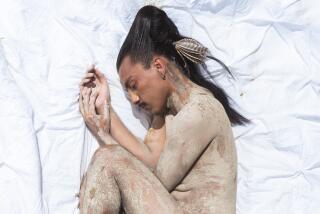DANCE REVIEW : Ballet Folklorico Creates Color Scene : Its spirited 40th anniversary program includes sold-out show at the Orange County Performing Arts Center.
COSTA MESA â Amalia Hernandezâs Mexico is like no place on Earth. With a painterâs eye, the founder-choreographer of Ballet Folklorico de Mexico intensifies an already dazzling cultural heritage until she creates a veritable wonderland: always recognizable yet unmistakably shaped by her vision.
Sponsored by the Orange County Philharmonic Society, the company gave a single, sold-out performance Wednesday at the Performing Arts Center and tonight begins a three-day engagement at Shrine Auditorium.
Along with many, many other achievements, its 40th anniversary program offers a festival of orange--with the color becoming a unifying motif as well as eventually seeming to exist in as many varieties as Mexican culture itself.
In the opening Mayan suite, watch for the swirl of women in white and gold against a backdrop depicting the great arch of Labna. Check out the spectrum of harmonized sands, beiges and pale oranges in the Chiapas segment. Look for the dusty earth tones in the Zacatecas suite, especially the âRevolutionâ scene with its red-orange scene painting of a derailed train. See how the light on the bleak landscape used for the âYaqui Deer Danceâ links the environment with the bare skin of the forceful lead dancer, Lucas Zarate. Finally, marvel at the startlingly vivid red-orange of the womenâs dresses in the Jalisco fiesta.
In contrast, âThe Olmecsâ is all green: the fluorescent, almost malachite-green of Mexican jade. Hernandezâs newest piece, it shows 30 dancers assembling in lines that meet in a right angle. From that formation, men in high head-dresses emerge to trap and subdue a jaguar. The beastâs feral leaping and crawling makes a potent comment on the groupâs stony rigidity and weight, but the final sequence may be far too short to achieve maximum ritual power.
Happily, for all the accuracy of their costumes, Hernandezâs dancers look nothing like the big-headed, baby-faced, pudgy Olmecs of ancient sculpture. Indeed, in their revealing Mayan vestments, the company men resemble nothing so much as antique codices and pottery-paintings redesigned by Soloflex.
But it is the Ballet Folklorico women who give the performance the irresistible lilt, wit and warmth of Mexican folk culture at its most gracious. Just three women swirling their full skirts at armsâ length fill a bare stage with splendor at the beginning of the Michoacan sequence. Later, when eight glide onstage to delicate marimba music wearing prismatic Chiapas floral gowns so finely wrought that the skirts grow translucent when lifted into the light, you donât have to be Mexican or Mexican-American to know youâre in Hernandez heaven.
More to Read
The biggest entertainment stories
Get our big stories about Hollywood, film, television, music, arts, culture and more right in your inbox as soon as they publish.
You may occasionally receive promotional content from the Los Angeles Times.










